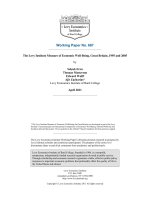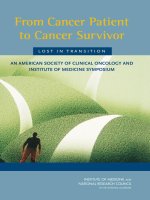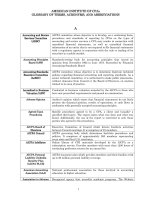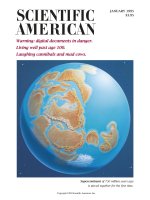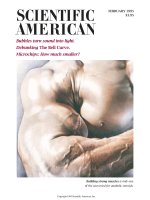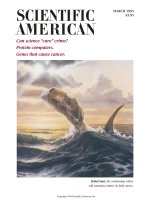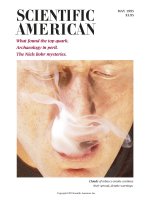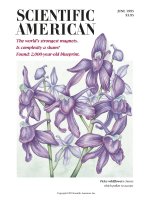Api tr 407 1995 (american petroleum institute)
Bạn đang xem bản rút gọn của tài liệu. Xem và tải ngay bản đầy đủ của tài liệu tại đây (2.16 MB, 81 trang )
American
Petroleum
Institute
Health and Environmental
Sciences Department
Tert-Amyl Methyl Ether (TAME)Acute Toxicity to Mysid Shrimp
(Mysidopsis bahia) under Static
Renewal Conditions
TSCA Guideline 5797.1930
TOXICOLOGY REPORT NUMBER 407
CAIS ABSTRACT NO. 42-1 520
Copyright American Petroleum Institute
Provided by IHS under license with API
No reproduction or networking permitted without license from IHS
Not for Resale
--`,,-`-`,,`,,`,`,,`---
FEBRUARY 1995
~~
A P I TR*407
~
95 W 0 7 3 2 2 9 0 0 5 5 4 9 8 3 733 W
41
.
E n v r r o n w l Partmbrp
One of the most significant long-term trends affecting the future vitality of the petroleum industry is the
public’s concerns about the environment. Recognizing this trend, API member companies have developed a
positive, forward-looking strategy called STEP: Strategies for Today’s Environmental Partnership.This program
aims to address public concerns by improving our industry’s environmental, health and safety performance;
documenting performance improvements; and communicatingthem to the public. The foundation of STEP is
the API EnvironmentalMission and Guiding Environmental Principles.
API ENVIRONMENTAL MISSION AND GUIDING ENVIRONMENTAL PRINCIPLES
The members of the American Petroleum Institute are dedicated to continuous efforts to improve the
compatibility of our operations with the environment while economically developing energy resources and
supplying high quality products and services to consumers. The members recognize the importance of
efficientlymeeting society’s needs and our responsibility to work with the public, the government, and others
to develop and to use natural resources in an environmentally sound manner while protecting the health and
safety of our employees and the public. To meet these responsibilities, API members pledge to manage our
businesses according to these principles:
o To recognize and to respond to community concerns about our raw materials, products and
operations.
+
9
To operate our plants and facilities, and to handle our raw materials and products in a manner that
protects the environment, and the safety and health of our employees and the public.
To make safety, health and environmental considerations a priority in our planning, and our
development of new products and processes.
o To advise promptly, appropriate officials, employees, customers and the public of information on
significant industry-related safety, health and environmental hazards, and to recommend
protective measures.
U* To counsel customers, transporters and others in the safe use, transportation and disposal of our
raw materials, products and waste materials.
9
To economicallydevelop and produce natural resourcesand to conservethose resources by using
energy efficiently.
9
To extend knowledge by conducting or supporting research on the safety, health and
environmental effects of our raw materials, products, processes and waste materials.
Q To commit to reduce overall emission and waste generation.
o To work with others to resolve problems created by handling and disposal of hazardous
substances from our operations.
o To participate with government and others in creating responsible laws, regulations and standards
to safeguard the community, workplace and environment.
9
lo promote these principles and practices by sharing experiences and offering assistance to
others who produce, handle, use, transport or dispose of similar raw materials, petroleumproducts
and wastes.
--`,,-`-`,,`,,`,`,,`---
Copyright American Petroleum Institute
Provided by IHS under license with API
No reproduction or networking permitted without license from IHS
Not for Resale
A P I TR*407
95
m
0732290 0554984 8 ï T
m
FOREWORD
API PUBLICATIONS NECESSARILY ADDRESS PROBLEMS OF A GENERAL
NATURE. WITH RESPECT TO PARTICULAR CIRCUMSTANCES, LOCAL,
STATE, AND FEDERAL LAWS AND REGULATIONS SHOULD BE
REVIEWED.
API IS NOT UNDERTAKING TO MEET THE DUTIES OF EMPLOYERS, MANUFACTLTRERS, OR SUPPLIERS TO WARN AND PROPERLY TRAiN AND
EQUIP THEIR EMPLOYEES, AND OTHERS EXPOSED, CONCERNING
HEALTH AND SAFETY RISKS AND PRECAUTIONS, NOR UNDERTAKING
THEIR OBLIGATIONS UNDER LOCAL, STATE, OR FEDERAL LAWS.
--`,,-`-`,,`,,`,`,,`---
NOTHING CONTAINED IN ANY API PUBLICATION IS TO BE CONSTRiJED
AS GRANTING ANY RIGHT, BY IMPLICATION OR OTHERWISE, FOR THE
MANUFACTURE, SALE, OR USE OF ANY METHOD, APPARATUS, OR PRODUCT COVERED BY LETTERS PATENT. NEITHER SHOULD A N Y T " G CONTAINED IN THE PUBLICATION BE CONSTRUED AS INSURING ANYONE
AGAINST LIABLI'TY FOR INFRINGEMENT OF LETTERS PATENT.
Copyright O 1995 American Petroleum Institute
Copyright American Petroleum Institute
Provided by IHS under license with API
No reproduction or networking permitted without license from IHS
Not for Resale
--`,,-`-`,,`,,`,`,,`---
A P I TRUY07 75
0732270 0554785 706
ACKNOWLEDGMENTS
-
THE FOLLOWING PEOPLE ARE RECOGNIZED FOR THEIR CONTRIBUTIONS OF TJME AND EXPERTISE DURING THIS STUDY AND IN THE
PREPARATION OF THIS REPORT
Richard Rhoden, Ph.D., Health and Environmental Sciences Department
-FO
ERS
EFFECTS WORKGROUP
Russell D. White,Ph.D., Chainnun, Chevron Research & Technology, Inc.
Rudolph J. Breglia, Ph.D., BP America, Inc.
Charles R. Clark, Ph.D., Unocal
Wayne Daughaey, Ph.D., Exxon Biomedical Sciences, Inc.
David Duncan, Texaco, Inc.
Francis J. Koscher, Ph.D., ARCO
Charles A. Lapin, Ph.D., ARCO
David C. Logan, M.D., Mobil Corporation
John H. Mitchell, M.D., Amoco Corporation
Susan A. Rodney, Ph.D., Texaco, Inc.
Ceinwen A. Schreiner, Ph.D., Stonybrook Laboratories
David R. Steup, Ph.D., Shell Oil Company
Michael S. Wells, Ph.D., Amoco Corporation
Copyright American Petroleum Institute
Provided by IHS under license with API
No reproduction or networking permitted without license from IHS
Not for Resale
American Petroleum Institute
Health and Environmental Sciences Department
QUALITY ASSURANCE/GLP COMPLIANCE STATEMENT
Tert-Amyl Methyl Ether (TAME) - Acute Toxicity to
the Mysid Shrimp(M&sis6&)Under
Static Renewal Conditions.
Teating Facility: Springborn Laboratories, Inc.
SLI Study Number: 12827.0394.6110.510
Study T i t l e :
This study was reviewed by API Quality Assurance personnel under
the direction of API Management on the dates indicated below for
compliance with EPA (TSCA) Good Laboratory Practice (GLP)
regulations. These studies were conducted in accordance with EPA
GLP regulations, with the exceptions* listed below, as well as
those listed on the Springborn GLP Compliance Statement.
Copies of reports by API Quality Assurance personnel are
available upon written request to the Director of the Health and
Environmental Sciences Department of the American Petroleum
Institute or his designee.
Date(s) of
Inspection/Review
Type of
Inspection
8/28/92
Protocol
Evaluation
8/28/92
Second Protocol
Review
4/25/94
4/25/94
Date of
Report to
Manaaement
4/27-28/94
In-Life Inspection
5/2/94
and Data Audit
6/13/94
Draft Report
Audit
6/14/94
10/15/94
Revised Final Draft
10/15/94
Report Review
12/21/94
Final Report
Review
12/30/94
--`,,-`-`,,`,,`,`,,`---
-ec>dí/p
Christine Seksmith
Quality Assurance Coordinator
12/21/94
Amended Final Report
Review and
Acceptance
12 /30/94
Jd&&$&
Date
*Test article characterization, other than that received by the
manufacturer (98.8% pure TAME) was not performed, storage
stability for this test article is not known, and the method of
fabrication is maintained with the test article supplier.
Copyright American Petroleum Institute
Provided by IHS under license with API
No reproduction or networking permitted without license from IHS
Not for Resale
A P I TR*407
95
m
0732290 0554987 589
Springborn Laboratories, Inc.
Environmental Sciences Diviaion
790 Main Street
Wareham, Massachusetts02571-1075
(506) 295-2550
Telex 4436041
Facsimile (508) 295-8107
AMENDMENT TO THE STUDY FINAL REPORT
Final Report Title:
Tert-Amyl Methyl Ether (TAME) - Acute Toxicity to Mysid Shrimp
(Mysidopsis bahia) Under Static Renewal Conditions
Amendment No.
1
SU Study No.
12827.O3!%.6110.51O
SU Report No.
94-5-5269
Study Sponsor:
American Petroleum Institute
Study Director:
Mark W. Machado
Amendment Date: 29 December 1994
Final Report Modifications and / or Additions:
Page 8:
The date of Protocol Amendment #1 was changed to the corrected date of the
amendment
Page 40-41 : The corrected version of Protocol Amendment #1 was included on these
pages
Approval Signatures:
t 2/99 ?!/Y
Date
Study Director
d ? C qLi
Date
--`,,-`-`,,`,,`,`,,`---
Patricia D. Royal
Manager, Regulatory Affairs and
Quality Assurance Unit
@Springborn
umaam
Copyright American Petroleum Institute
Provided by IHS under license with API
No reproduction or networking permitted without license from IHS
Not for Resale
A P I TR*407
95 I0 7 3 2 2 9 0 0 5 5 4 9 8 8 415 I
Page 1 of 73
-
TEM-AMYL METHYL ETHER (TAME)
ACUTE TOXICITY TO MYSID SHRIMP
(Mysldopsls brhia) UNDER STATIC
RENEWAL CONDITIONS
TSCA Guideline 5 797.1 930
Submitted to:
American Petroleum Institute
1220 L Street, Northwest
Washington, D.C. 20005
--`,,-`-`,,`,,`,`,,`---
S U Report #94-5-5269
SU Study #12827.0394.6110.51 O
Study Director: Mark W. Machado
Springborn Laboratories, Inc.
Environmental Sciences Division
790 Main Street
Wareham, Massachusetts 02571-1075
29 December 1994
AMENDED FINAL REPOFIT
Copyright American Petroleum Institute
Provided by IHS under license with API
No reproduction or networking permitted without license from IHS
Not for Resale
A P I TR*407
95
0 7 3 2 2 9 0 0 5 5 4 9 8 9 351
Page 2 of 73
Report No. 94-5-5269
GOOD LABORATORY PRACTICE COMPUANCE STATEMENT
--`,,-`-`,,`,,`,`,,`---
-
The data and report presented for Tert-Amyl Methyl Ether (TAME) Acute Toxicity to
Mysid Shrimp (Mysidopsis bahia) Under Static Renewal Conditions' were produced and
compiled in accordance with all pertinent EPA Good Laboratory Practice Regulations (40 CFR,
Part 792) with the following exception: routine water and food contaminant screening analyses
for pesticides, PCBs and toxic metals. These analyses were conducted using standard US. EPA
procedures by Lancaster Laboratories, Lancaster, Pennsylvania. These data were not collected
in accordance with Good Laboratory Practice procedures (Le., no distinct protocol, Study
Director, etc.). Storage stability, characterization and verification of the test substance identity
and maintenance of these records on the test substance are the responsibility of the Study
Sponsor.
Total organic carbon analyses for filtered seawater conducted by Galbraith
Laboratories, Knoxville, Tennessee, utilized standard U.S. EPA procedures, but were not
conducted in accordance with Good Laboratory Practice procedures. At the termination of the
testing program, all remaining test substance will be sent to the Study Sponsor. Archival of a
sample of the test substance is the responsibility of the Study Sponsor.
SPRINGBORN LABORATORIES, INC.
Maik W. Machado
Study Director
Springborn Laboratories, Inc.
Copyright American Petroleum Institute
Provided by IHS under license with API
No reproduction or networking permitted without license from IHS
Not for Resale
daté
'
A P I TR*407
95
= 0732290
0 5 5 4 9 9 0 073
Report No . 94-55269
=
Page 3 of 73
TABLE OF CONTENTS
Page
....................
.......................................................
USTOFFIGURES .......................................................
SUMMARY ............................................................
USTOFTABLES
.....................................................
2 0 MATERIALS AND METHODS ...........................................
2.1 Protocol ......................................................
1.0IMRODUCTION
................................................
................................................
.............................................
...............................................
............................................
....................................
3.0 TEST PROCEDURES ................................................
3.1 Stability and Aqueous Solubility Trials ..............................
3.2 Test Initiation .................................................
2.2
2.3
2.4
2.5
2.6
27
Test Substance
Test Organisms
Test Dilution Water
Test Conditions
Test Concentrations
Exposure Solution Preparation
B ...............................................
.....................................
........................................
3.3 Test Monitorin
3.4 Water Quality easurements
3.5 Analytical Measurements
2
4
5
6
8
8
8
8
9
10
11
11
11
12
12
13
13
13
13
.......................................................
14
5.0RESULTS .........................................................
15
5.1 Prelimjna Test ...............................................
15
5.2 DefinitNeyest ................................................
16
5.2.1 Evaluation of Test Conditions .............................. 16
5.2.2 Analytical Results .......................................
17
5.2.3 Biological Results .......................................
17
PROTOCOL DEVIATIONS ................................................
19
QUAUTY ASSURANCE UNIT STATEMENT ..................................
20
REFERENCES ........................................................ 21
SIGNATORES AND APPROVAL ...........................................
30
6.0 APPENDIX I - STUDY PROTOCOL ......................................
31
7.0 APPENDIX II - CERTIFICATE OF ANALYSIS ...............................
42
8.0 APPENDIX 111 - CULTURE FOOD ANALYSIS ...............................
45
9.0 APPENDIX IV - DILUTION WATER ANALYSIS .............................
48
10.0 APPENDIX V - ANALYnCAL METHODOLOGY ............................ 53
11.0 APPENDIX VI - RAW DATA ...........................................
67
4.0STATISTICS
.
Springborn Laboratories. Inc
Copyright American Petroleum Institute
Provided by IHS under license with API
No reproduction or networking permitted without license from IHS
Not for Resale
--`,,-`-`,,`,,`,`,,`---
GOOD LABORATORY PRACTICE COMPLIANCE STATEMENT
Page 4 of73
Report No. 94-5-5269
UST OF TABLES
Page
Table 1.
nie water quality parameters measured during the 96-hour
static renewal exposure of mysid shrimp (Mysidopsis bahia) t o
TAME
Table 2.
....................................................
Concentrations of TAME measured in the replicate (A,B) test
solutions during the 96-hour static renewal exposure of mysid
shrimp (Mysldopsis bahia)
24
Mean measured concentrations tested, corresponding
cumulative percent mortality and observations made during the
96-hour static acute exposure of mysid shrimp (AßysMopsis
bahia) to TAME
25
The LC50 values, corresponding 95% confidence intervals and
the No-ûbserved-Eff ect Concentration (NOEC) for the 96-hour
static renewal toxicity test exposing mysid shrimp (Mysidopsis
bahla) to TAME
26
....................................
Table 3.
............................................
Table 4.
Table iA.
Table 2A
Table 3A.
Table 4A
............................................
Analytical results for the recovery of TAME from AAP media .........
60
Analytical results for the recovery of TAME from filtered
seawater
61
Analytical results for the recovery of TAME from freshwater
(reconstituted to increase hardness)
62
Repeatability of TAME analysis from ASTM Type II water at
0.026mgA
63
..................................................
...........................
................................................
--`,,-`-`,,`,,`,`,,`---
Springborn Laboratories, Inc.
Copyright American Petroleum Institute
Provided by IHS under license with API
No reproduction or networking permitted without license from IHS
23
Not for Resale
A P I TRd407 95
0732290 0554992 946
Report No. 94-5-5269
Page 5 of 73
LIST OF FIGURES
Page
Figure 1.
Relationship between mean measured concentrations (analysis
at 0- and 96-hours) and the nominal treatment levels
established during the 96-hour static renewal toxicity test
exposing mysid shrimp (Mysidopsis bahia) to TAME ............... 28
Figure 2.
The 96-hour concentration-response (mortality) cuwe for the
static renewal toxic*Rytest exposing mysid shrimp (Mysicfopis
............................................
29
A representative chromatogram of TAME purge and trap
GCFID analysis ............................................
64
A representativelinear regressionanalysis from standard TAME
analysis
65
A representative polynomial regression analysis from standard
TAME analysis .............................................
66
bahia)toTAME
Figure 1A
Figure 2A.
Figure 3A
..................................................
--`,,-`-`,,`,,`,`,,`--~
Springborn Laboratories, Inc.
Copyright American Petroleum Institute
Provided by IHS under license with API
No reproduction or networking permitted without license from IHS
Not for Resale
~~
-
Page 6 of 73
Report No. 94-5-5269
SUMMARY
The purpose of this study was to estimate the acute toxicity (LC50)of Ten'-Amyl Methyl
Ether (TAME) to mysid shrimp (Mysidopsisbahia) under static renewal conditions. The LC50 is
defined as the concentrationof the test substance in dilution water which causes mortality of 50%
in the exposed test population after a fixed period of time. Twenty organisms (ten per replicate)
were exposed in duplicate test vessels to each of six concentrations of TAME and a dilution
water control for 96-hours. During the test, nominal concentrations of 1.6, 4.0, 7.3,15, 30 and
60 mg A.I./L were maintained by renewing solutions at 24,4& and 72-hours of exposure. Each
replicate solution was sampled and analyzed for TAME concentration at O-hour (test initiation)
and 96-hours (test termination) of exposure. Due to the variability between replicates and
sampling intervals, the analytical results obtained for the lowest treatment level will not be
reported. Based on the results of these anaiyses, the mean measured exposure concentrations
were defined as 5.0, 9.5, 19, 35 and 65 mg A1.L Biological observations and observations of
the physical characteristics of the exposure solutions were made and recorded at test initiation
and every 24 hours thereafter until the test was terminated. Throughout the exposure period,
treatment level solutions were observed to be clear and colorless and contained no visible sign
of undissolved test substance (e.g., precipitate).
At test termination (96-hours), 100% mortality was observed among mysids exposed to
the highest mean measured concentration tested (65 mg AAL). Mortality of 60 and 95% was
observed among mysids exposed to the 19 and 35 mg A.l.lL treatment levels, respectively, while
mortality of 20 and 10% was observed among mysids exposed to the 5.0 and 9.5 mg A.1.L
treatment levels, respectively. Sublethal effects (e.g., lethargy, darkened pigmentation) were
observed among all of the suhving mysids exposed to the 19 and 35 mg A.I./L treatment level
and among several of the surviving mysids exposed to the 5.0 and 9.5 mg A.I./L treatment levels.
Mortality of 5% was observed in the lowest treatment level tested (¡.e., 1.6 mg A.I./L, nominal) with
two of the suhving mysids observed to be lethargic. The LC5û values, 95% confidence intervals
and No-Observed-EffectConcentration (NOEC) established during this study are summarized in
the following table.
Springborn Laboratories, Inc.
--`,,-`-`,,`,,`,`,,`---
Copyright American Petroleum Institute
Provided by IHS under license with API
No reproduction or networking permitted without license from IHS
Not for Resale
Page 7 of 73
Report No. 94-5-5269
TEST RESULTS
No-O bservedEffect Concentration
Through 96 Hours
(mg ALL)'
LC50
(mg A!./L)'b
a
'
24-HouF
48-HouS
72-HOüP
96-Hour'
> 65
>65
18
(13 23)
14
(10 19)
-
-
< 5.0
Based on mean measured concentrations of TAME (as active ingredient).
Corresponding 95% confidence interval is presented in parentheses.
Le50 value empiricaliy estimated as being greater than the highest mean measured concentration
tested.
LC50 value and 95% confidence interval calculated by probit analysis.
LC50 value and 95% confidence interval calculated by moving average angle analysis.
Springborn Laboratories, Inc.
--`,,-`-`,,`,,`,`,,`---
Copyright American Petroleum Institute
Provided by IHS under license with API
No reproduction or networking permitted without license from IHS
Not for Resale
~
A P I TR*407
95
= 0732290
0 5 5 4 9 9 5 655
Page 8 of 73
Report No. 94-5-5269
1.O INTRODUCTION
The purpose of this study was to estimate the acute toxicity (LC50) of TAME to mysid
shrimp (Mysidopsis bahia) under static renewal test conditions. The LC50 is defined as the
concentration of the test substance in dilution water which causes mortality of 50% in the
exposed test population after a fixed period of time. This value is often used as a relative
indicator of potential acute hazards resulting from release of the test substance into aquatic
environments. The study was initiated on 25 April 1994, the day the Study Director signed the
protocol, and was completed on the day the Study Director signed the final report. The
experimental phase of the 96-hour definitive test was conducted from 3 to 7 May 1994 at the
Environmental Sciences Division of Springborn Laboratories, Inc. (SLI), located in Wareham,
Massachusetts. Ail original raw data and a copy of the final report will be stored with the Study
Sponsor. A final report for this study was issued to American Petroleum Institute dated 19
December 1994. This amended final report, 28 December 1994, incorporates changes made as
presented in Final Report Amendment #1.
2.0 MATERIALS AND METHODS
2.1 Protocol
Procedures used during this acute toxicity study followed those described in the
Springborn protocol entitled "TAME: Acute Toxicity to Mysids (Mysidopsis bahia) Under StaticRenewal Conditions, Following TSCA Guideline 797.1930", Springborn Laboratories Protocol
#:042594/TSCA/51OTTAME (dated 25 April 1994) and Protocol Amendment #1 (dated 17 May
--`,,-`-`,,`,,`,`,,`---
1994) (Appendix i).
The methods described in this protocol generally follow the standard
procedures described in the U.S. EPA Toxic Substance Control Act (TSCA) Test Guidelines §
797.1930 (U.S. EPA, 1985). Where applicable, Springborn Laboratories, Inc. Standard Operating
Procedures (SOP)were followed during the conduct of the study.
2.2 Test Subeance
Two silmples of Tert-Amyl Methyl Ether (TAME) (CAS # 994-05-8), a clear liquid, were
received from Experimental Pathology Labs, Inc., Herndon, Virginia.
Springborn Laboratories, Inc.
Copyright American Petroleum Institute
Provided by IHS under license with API
No reproduction or networking permitted without license from IHS
Not for Resale
The first sample,
A P I TR*407
95 W 0732290 0554996 5 9 1 W
Report No. 94-5-5269
Paae 9 of 73
~
Lot # 0281 482,was received at SU on 17 August 1992 and was used to prepare analytical
standards during the method validation/recovery study and to prepare Qualrty Control samples
during the definitive exposure. The sample was identified by Aldrich Chemical to contain 98.8%
--`,,-`-`,,`,,`,`,,`---
active ingredient; A.I. (Certificate of Analysis, Appendix Il). The second sample, Lot # 07905KZ,
was received at SLI on 2 November 1992 and was used to prepare exposure solutions during
the preliminary and definitive exposures. The sample was identified as reagent grade by Aldrich
Chemical and contained 98.7% active ingredient (Certificate of Analysis, Appendix Il). Upon
receipt at SU, the samples of test substance were stored in a dark, ventilated cabinet at room
temperature (approximately 20 OC). Test concentrations are expressed as milligrams of test
substance (as active ingredient) per liter of test solution and are reported as mg A.I./L.
At the request of the Study Sponsor, mass spectral analysis was conducted on the initial
batch of TAME received at program initiation, and the additional batches receivedthroughout the
course of the program. The purpose of the mass spectral analysis evaluation was to determine
test material integrity throughout the duration of the program. Initial evaluation of test material
(Le., lot # 0281482) was conducted on 3 December 1992. Following completion of this flowthrough acute toxicity test with mysids, spectral analysis was conducted on 20 July 1994 on each
of the remaining two lots (lot # O281482 and lot # 07905KZ). The spectral analysis conducted
on 20 July 1994 on the two remaining lots in comparison to the initial spectral analyses of lot
# 0281482 established that negligible change in test material composition had occurred during
storage at Springborn Laboratories, Inc. (Le., approximateiy 24 months).
2.3 Test Organisms
The mysid shrimp (Mysidopsis bahia) was selected as the test species since it is a
recommended (US.EPA, 1975)species and commonly used warm water marine invertebrate in
static acute toxicity tests. The mysid shrimp used during this study (SLI Lot #94A28) were
produced by broodstock originally obtainedfrom Aquatic Biosystems, Inc., a commercial supplier
in Ft. Collins, Colorado, an1 held at Springborn in a 500-L fiberglass tank under a photoperiod
of 16 hours of light and 3 ..lours of darkness. A closed loop recirculating filtration system
provided natural seawater to the holding tank. The seawater was characterized as having a
Springborn Laboratories, Inc.
Copyright American Petroleum Institute
Provided by IHS under license with API
No reproduction or networking permitted without license from IHS
Not for Resale
A P I TR*407
95
0 7 3 2 2 9 0 0554997 4 2 8
Page 10 of 73
Report No. 94-5-5269
salinity ranging from 19 to 21 %o and a pH of 7.6.Test organisms were maintained under these
conditions for a minimum of 14 days prior to testing. The temperature in the holding tank was
24 OC during this 14day period. Juvenile mysids,
si
24 hours old, were collected using a
variation of the method described by Reitsema and Neff (1 980). The mysids were fed live brine
--`,,-`-`,,`,,`,`,,`---
shrimp, Artemia salina, nauplii twice daily (Daily Record of Mysid Culture Conditions).
Representative samples of the food source were analyzed for the presence of pesticides, PCBs
and toxic metals (Appendix Ill). Food sources were consideredto be of acceptable quality since
the total concentration of pesticide measured was less than 0.3 mg/kg (ASTM, 1985).
2.4 Test Dilution Water
The dilution water used during this study was from the same source as the water which
flowed into the tank used to hold the mysid shrimp. The dilution water was collected from the
Cape Cod Canal, Bourne, Massachusetts with a pump (fiberglass reinforced thermoplastic
housing) and a potyvinyl chloride (PVC) pipe and was then transported to the laboratory in a
3400-L fiberglass tank.
In the laboratory, the seawater was passed through a series of
polypropylenecore filters (20-and Smicron) and then recirculatedwithin an epoxy-linedconcrete
reservoir prior to use. The seawater was pumped to the laboratory under constant pressure
through PVC pipe and a polypropylene heat exchanger system. The seawater used during this
study had a salinity range of 31 to 33 '/o0 and a pH range of 7.9 to 8.0. The salinity of the
seawater used in the test was adjusted to 20 f 3 %o by diluting with freshwater. The freshwater
is characterized as soft and is a combination of on-site well water and Town of Wareham well
water. Representative samples of the seawater as well as the freshwater used to adjust the
salinity were analyzed for the presence of pesticides, PCBs and toxic metals (Appendix IV). None
of these compounds have been detected at concentrations that are considered toxic in any of
the water samples analyzed, in agreement with U.S.EPA and ASTM (1 985)standard practices.
In addition, representativesamples of the seawater as well as the freshwater used were analyzed
monthly for total organic carbon (TOC) concentration. These analyses establishedthat the TOC
concentration of the seawater and freshwater ranged from 0.84to 2.9 mg/L and 0.43to 0.79
mg/L, respectively, for the months of Ndvnmoer 1993 to April 1994 (TOC and TSS Master Log,
Vol. 1). Several species of mysid shrimp are maintained in water from the same source as the
Springborn Laboratories, Inc.
Copyright American Petroleum Institute
Provided by IHS under license with API
No reproduction or networking permitted without license from IHS
Not for Resale
A P I TR*407
95
0732290 0554998 364
Report No. 94-5-5269
Page 11 of 73
dilution waters utilized during this study and have successfully survived and reproduced over
several cuiture generations. The performance of the mysid cultures, in combination with the
previously mentioned analyses, confirms the acceptability of this dilution water for use during the
conduct of bioassays.
2.5 Test Conditions
The test system was designed to provide six concentrations of TAME and a dilution water
control to duplicate test vessels. Test vessels were labeledto identify the nominal test substance
concentration and designated replicate. Test vessels were impartially placed in a temperature
controlled waterbath designed to maintain solution temperatures at 25 f 2 OC. A photoperiod of
14 hours light and 1O hours darkness provided light with an intensity of 30 footcandles at the
surface of the test solutions was provided by Dura-Test Vita-Lite@fluorescent bulbs. Sudden
transitions from light to dark and vice versa were avoided.
2.6 lest Concentrations
Selection of nominal TAME concentrations for the 96-hour definitive toxicity test with
Mysicfopsis bahia was based on toxicrty information developed at Springbornthrough preliminary
testing. The nominal concentrations chosen were 1.6, 4.0, 7.3,15, 30 and 60 mg A.I./L.
2.7 Exposure Solution Preparation
The toxicity test was conducted in glass mason jars which contained a total solution
volume of 940 mL. The test solution in each vessel had a depth of 16 cm and a surface area of
28.3 cm2. Duplicate test vessels were established for each treatment level and the control.
Control vessels were established which contained the same dilution water as the exposure
concentrations but contained no test substance. Replicate treatment level solutions were
prepared individually by volumetric addition of the appropriate amount of test substance directly
to the test vessels which were previously filled to 90% capacity with dilution water. The test
vessels were then completely filled to the top with dilytim water, leaving no headspace, covered
with a metal screw-top lid with a Teflon* liner to minimize evaporation and loss of test substance
due to volatilization and inverted several times ensuring adequate moting. Test solutions were
Springborn Laboratories, Inc.
--`,,-`-`,,`,,`,`,,`---
Copyright American Petroleum Institute
Provided by IHS under license with API
No reproduction or networking permitted without license from IHS
Not for Resale
~
API TR*407 95
~~
0 7 3 2 2 9 0 0 5 5 4 9 9 9 2TO
Report No. 94-5-5269
Page 12 of 73
~~
renewed at the 24-, 40- and 72-hour interval. A duplicate set of exposure vessels was
established to prepare fresh renewal solutions. Solutions were renewed by carefully siphoning
the aged solution out of the test vessel using an inverted glass powder funnel and a length of
silastic tubing. The open end of the funnel was covered with 363 micron Nitex* screen attached
with silicone adhesive to prevent loss of mysids. Approximately 90% of the aged solution was
removed, leaving an adequate amount of solution remaining for surviving mysids. Freshly
vessel using the funnel.
3.0 TEST PROCEDURES
--`,,-`-`,,`,,`,`,,`---
prepared solution was added to the test vessel in the same manner by siphoning into the test
3.1 Stability and Aqueous Solubility Trials
Prior to initiation of this study, a stability and aqueous solubility evaluation of TAME was
conducted at Springborn Laboratories, Inc. The evaluation was conducted in a closed system
designed to minimize headspace at a nominal concentration of 600 mg A.I./L and in the presence
of test organisms (sheepshead minnow).
The test solution was analyzed for TAME
concentrations at O, 24, 48 and 96 hours of exposure.
The average measured concentration of TAME at 0,24, 48 and 96 hours of the exposure
period was 755, 491 , 484 and 343 mg A.I./L, respectively. Although the O-hour recoveries were
somewhat higher than anticipated, the results established that under the maintained test
conditions, the test material was relatively stable during the initial a h o u r s of the exposure
period. These results also suggest that the water solubility under these conditions approximate
500 to 600 mg A.I./L In addition, dissolved oxygen concentration measured during this test
indicated that in the presence of test organisms (sheepshead minnow), the dissoived oxygen
concentration fell below 60% of saturation following 48 hours.
The above results established that TAME was generally stable for a period of 48 hours
under the maintained test conditions and support the premise thql it i3 sppropriate to conduct
the tests with TAME under static renewal conditions. Since dissolved oxygen concentrationsfell
below 60% of saturation at 48 hours of exposure, the mysid study was conducted with 24-hour
Springborn Laboratories, lnc.
Copyright American Petroleum Institute
Provided by IHS under license with API
No reproduction or networking permitted without license from IHS
Not for Resale
A P I TR*k407 95
= O732290
m
0555000 bL0
Report No. 94-5-5269
Paae 13 of 73
~~
~
~~
~
renewals to avoid the potential for low dissolved oxygen concentrations during the in-life portion
of the study.
3.2 Test Initiation
The test was initiated when ten mysid shrimp (S 24 hours old, 20 per treatment level and
the control) were impartially selected and distributed to each replicate vessel. Mysids were
added two at a time to each replicate aquarium until each aquarium contained 10 mysids.
Mysids were fed brine shrimp nauplii (Artemia salina) once daily during the exposure period.
3.3 Test Monitoring
Biological observations of the exposed mysid shrimp and observations of the physical
characteristics of the test solutions were recorded at test initiation and at each subsequent 24hour interval until test termination (96 hours). Mortalities were recorded and removed from each
3.4 Water Quality Measurements
Dissolved oxygen concentration, pH, salinity and temperaturewere measured once daily
in both replicates of each treatment level and the control. At each renewal interval (¡.e., 24, 48
and 72 hours) water quality measurementswere taken from both the newly prepared and old test
solutions. Salinity was measured with an ATAGO refractometer. The pH was measured with a
Jenco Model 601A pH meter and combinationelectrode; the dissolved oxygen concentrationwas
measured with a Yellow Springs Instrument (YSI) Model #57 dissolved oxygen meter and probe
and the daily temperature was measured with a Brooklyn alcohol thermometer. tight intensity
was measured with a General Electric type 214 light meter. Continuous temperature monitoring
of the surrounding water in the waterbath was also performed using a Fisher Scientific Min/Max
thermometer.
3.5 Analytical Measurements
During the definitive exposure period, water samples were removed from each replicate
solution of each treatment level and the control at O and 96 hours for the analysis of TAME
Springborn Laboratories, Inc.
Copyright American Petroleum Institute
Provided by IHS under license with API
No reproduction or networking permitted without license from IHS
Not for Resale
--`,,-`-`,,`,,`,`,,`---
test vessel every 24 hours during the exposure period.
A P I TR*40?
9 5 W 0732270 0555003 5 5 7 W
Report No. 94-5-5269
Page 14 of 73
concentration. Samples analyzed at the O-hour sampling interval were removed from the freshly
prepared test solutions. Samples analyzed at the 96 hour sampling interval were removed from
the aged (24hour old) exposure solutions. Each exposure solution sample was collected from
the approximate midpoint of the test vessel with a volumetric pipet. In addition, three Quality
Control (QC) samples were prepared at each sampling interval and remained with the exposure
solution samples throughoutthe analytical process. These QC samples were prepared in dilution
water at concentrations of TAME similar to the exposure concentration range. Results of the
analyses of the QC samples were used to judge the precision and quality control maintained
during the analysis of exposure solution samples. Ail samples were analyzed for TAME using
a gas chromatographic (GC) procedure according to the methodology described in Appendix V.
A method validation study conducted at SLI prior to the initiation of the definitive test, established
an average recovery of lo4
f
1 1 % for filtered seawater. Conditions and procedures used
throughout the analysis of exposure solution samples and QC samples during this study were
similar to those described in Appendix V.
4.0 STATISTICS
The mean measured concentrations tested (based on O- and %-hour analyses) and the
corresponding biological response (mortality) derived from the definitive toxicity test were used
to estimate the median lethal concentrations (LC50) and 95% confidence limits at each 24-hour
interval of the exposure period. The LC50 is defined as the concentration of the test substance
in dilution water lethal to 50% of the test organism population at the stated exposure interval.
If
5
50% mortality was observed in any of the concentrations tested, the LC50 value was
estimated to be greater than the highest treatment level tested and no statistical analyses were
performed. If at least one test concentration caused mortality of greater than or equal to 50%
of the test population, then a computer program (Stephan, 1982,personal communication) was
used to calculate the LC50 values and 95% confidence limits.
Three statistical methods were available in the computer program: moving average angle
analysis, probit analysis, and nonlinear interpolation with 95% confidence limits calculated by
--`,,-`-`,,`,,`,`,,`---
Springborn Laboratories, Inc.
Copyright American Petroleum Institute
Provided by IHS under license with API
No reproduction or networking permitted without license from IHS
Not for Resale
A P I TR*407
95
0732270 0 5 5 5 0 0 2 4 9 3
Report No. 94-5-5269
m
Page 15 of 73
binomial probability. Moving average angle and probit analyses yield statistically sound results
only if at least two concentrations produce a mortality of between O and 100% of the test
organism population. The selection of reported LC50 values and 95% confidence limits was
based upon an examination of the data base and the resuitc of the computer analysis. Selection
criteria included the establishment of a concentration-effect (mortality) relationship, the number
of concentrations causing partial responses, and the span of responses bracketing the LC50
value. if two or more statistical methods produced acceptable results, then the method which
yielded the smallest 95% confidence limit was selected. The No-Observed-Effect Concentration
(NOEC) during the 96-hour exposure period was also determined. The NOEC is defined as the
highest concentration tested at and below which there were no toxicant related mortalities or
physical and behavioral abnormalities (e.g., lethargy) with respect to the control organisms.
5.0 RESULTS
Copies of excerpted raw data on the exposure conditions (e.9. water quality, test
substance concentration analyses) and the concentration-effect response are presented in
5.1 Preliminary Test
Prior to initiating the definitive study, several preliminary range-finding tests were
conducted at SLI. An initial preliminary study was conducted in which mysid shrimp were
exposed under static renewal conditions with zero headspace at nominal TAME concentrations
of 0.81 , 11, 11O and 500 mg A.I./L and a dilution water control. This study was conducted to
evaluate the mysid shrimp age class which is most sensitive to exposure to the test substance.
Following 96 hours of exposure, mortality of O, 1O, 40 and 100% was observed among the s 24
hour old mysid age class exposed to the 0.81 , 11, 110 and 500 mg A.I./L concentrations,
respectively. Mortalities ranging from O to 10% were observed among the 5 to 6 day old mysid
age class exposed to the same nominal concentrations. Based on these resuits, it was
determined that the L 24 hour old mysids were the most sensitive age class and would be used
in the definitive study.
Springborn Laboratories, Inc.
Copyright American Petroleum Institute
Provided by IHS under license with API
No reproduction or networking permitted without license from IHS
Not for Resale
--`,,-`-`,,`,,`,`,,`---
Appendix VI.
A P I TR*40ï
95 W O732290 0555003 32T
=
Report No. 94-5-5269
Page 16 of 73
~
An additional preliminary exposure was conducted prior to initiating the definitive study.
Mysid shrimp were exposed under static renewal conditions (zero headspace) to nominalTAME
concentrations of 0.81 , 2.4, 5.7, 13, 32, 81 and 200 mg A.I./L and a dilution water control.
Following 48 hours of exposure, 100%mortalitywas observed in the highest concentrationtested
(200 mg A.I./L). At test termination (72 hours), mortality of 50 and 100% was observed among
organisms exposed to the 32 and 81 mg A.I./L treatment levels, respectively, while mortality
ranging from 20 to 40% was observed among mysids exposed to the remaining concentrations
tested (0.81 to 13 mg A.I./L),
Sublethal effects (e.g., lethargy, darkened pigmentation) were
observed among surviving organisms exposed to all of the concentrations tested except for the
lowest concentration (0.81 mg A.I./L). Based on these results, nominal concentrations of 1.6,4.0,
7.3, 15, 30 and 60 mg A.I./L
were selected for the definitive test.
Based on the results of preliminary exposures, an initial definitive test was initiated by
exposing mysids to nominal TAME concentrations ranging from 16 to 500 mg/L. Results of the
analysis of the exposure solutions at O hour established measured concentrations which were
only approximately 25% of the nominal fortified levels. Additional investigations determined that
additional mixing of the solutions prior to addition of the test organisms significantly increased
solubility of the test article and increased recoveries.
Based on the results of these
investigations,the initial definitive test was terminated at 72 hours. Since only approximately 25%
of the added material was recovered in the exposure solutions during this initial definitive test,
the concentration response observed during this study may have been influenced by undissolved
material and therefore, may not accurately define the toxicity of TAME based on the available
measured concentrations (Le., approximately 25% of nominal). Subsequently, preliminary testing
was performed using the modified solution preparation procedure (Le., additional mixing) to
establish the exposure concentrations for subsequent definitive testing.
5.2 Definitive Test
5.2.1 Evaluation of Test Conditions
-
Results of the water quality parameters (pH,
dissolved oxygen concentration,temperature, and salinity) measured during the definitive toxicity
test are presented in Table 1. All water quality parameters measured were unaffected by the
Springborn Laboratories, Inc.
--`,,-`-`,,`,,`,`,,`---
Copyright American Petroleum Institute
Provided by IHS under license with API
No reproduction or networking permitted without license from IHS
Not for Resale
~
A P I TR*407
'75
=
0 7 3 2 2 9 0 0555001i 2 b b
Page 17 of 73
Report No. 94-5-5269
concentration of TAME and remained within acceptable ranges for the sunival of mysid shrimp.
Daily measurementof the temperature in the test solutions established that the exposure solution
temperatures ranged from 24 to 25 OC throughout the test period. Continuous temperature
monitoring of the surrounding water in the waterbath established that the exposure solution
temperatures ranged from 24 to 26 OC throughout the test period.
5.22 Analytical Results
- The results of the analyses ofthe exposure solutions for
TAME concentration during the exposure period are presented in Table 2. Analysis performed
at O hour for the 1.6 mg A.1.R (nominal) treatment level resulted in measured concentrations
which were variable and inconsistent with percent recoveries established at other treatment
levels. An additional set of samples from the 1.6 mg AI./L treatment level were removed and
anaiyzed after the 24-hour interval of this study in an attempt to reevaluate exposure conditions.
Results of these analyses along with the samples analyzed at 96 hours demonstrated
considerable variability as compared to the &hour analysis for this treatment level. Due to
resulting variability between replicate exposure solutions and sampling intervals, a mean
measured concentration Will not be calculated for this treatment level; all conclusions will be
basedon the nominal concentration. Mean measuredconcentrations for the remaining treatment
levels averaged 121% of nominal and defined the concentrations as 5.0, 9.5, 19, 35 and
65 mg AI./L
Figure 1 presents the relationship of the nominal to mean measured
concentrations. Analysis of the Quality Control (QC) samples at each sampling interval (O and
96 hours) resulted in measured concentrations which were consistent with the predetermined
recovery range (Appendix V) and averaged 98% (N = 6) of the nominal fortified levels (1.5 to 60.0
mg A.I./L), Based on the results of these analyses, it was determined that the appropriate quality
control was maintained during the analyses of the exposure solutions.
5.2.3
Biological Results
-
The mean measured concentrations tested, the
corresponding cumulative percent mortality and the observations made during the definitive
exposure are presented in Table 3. At test termination (9&hours), 100% mortality was observed
among mysids exposed to the highest mean measured concentration tested (65 mg A.I,/L).
Mortality of 60 and 95% was observed among mysids exposed to the 19 and 35 mg A.I./L
Springborn Laboratories, lnc.
--`,,-`-`,,`,,`,`,,`---
Copyright American Petroleum Institute
Provided by IHS under license with API
No reproduction or networking permitted without license from IHS
Not for Resale
~
A P I TR*407
95
0 7 3 2 2 9 0 0555005 L T 2
Page 18 of 73
Report No. 94-5-5269
treatment levels, respectively, while mortality of 20 to 10% was observed among mysids exposed
to the 5.0 to 9.5 mg kl./L treatment levels, respectively. Sublethal effects (e.g., lethargy,
darkened pigmentation) were observed among all of the surviving mysids exposed to the 19 and
35 mg A.I./L treatment level, among several of the sunriving mysids exposed to the 5.0 and
--`,,-`-`,,`,,`,`,,`---
9.5 mg A1.L treatment levels. Mortality of 5% was observed in the lowest treatment level tested
(1.6 mg A.l./L, nominal) with two of the sunriving mysids observed to be lethargic. Figure 2
presents the =hour
concentration-response (mortaiiỵy) curve established for this study. Due
to the lack of analytical data to define the exposure concentration in the lowest (nominal)
treatment level tested (1.6 mg A.l./L), the NOEC is conservatively estimated as < 5.0 mg k1.L
Data obtained for the lowest treatment level were also excluded from the calculation of the LC50
value as well.
Table 4 presents the LC50 values, corresponding 95% confidence intervals and the NoObsetved-Effect Concentration (NOEC). Based on mean measured concentrations, the %hour
LC50value for mysid shrimp exposed to TAME was calculated by moving average angle analysis
to be 14 mg A.I./L (95% confidence interval 10 to 19 mg AI./L).
Springbom Laboratories, Inc.
Copyright American Petroleum Institute
Provided by IHS under license with API
No reproduction or networking permitted without license from IHS
Not for Resale
API TR*407
95
0 7 3 2 2 9 0 0 5 5 5 0 0 6 O39
Report No. 94-5-5269
Paqe 19 of 73
PROTOCOL DEVIATIONS
1.
The study protocol states that the calculated LC50 will be based on measured
concentrations of the six test substance concentrations establishedduring the study.
In this study, six test substance concentrations were established for the definitive
study and samples were taken in all replicate test solutions and the negative control
at test initiation and termination for analysis of test substance concentration. Results
obtained for the lowest treatment level, however, were omitted from the calculation
of the LC50 due to the noted variability in measured concentrations, preventing an
accurate assessment of the exposure conditions. Since the biological responses at
measured concentrations 5 9.5 mg/L were very similar, calculation of the LC50 will be
unaffected by the elimination of the low treatment level (Le.,1.6 mg/L, nominal)
established in this study.
2.
The study protocol states that dissolved oxygen concentration will not be allowed to
exceed 105% of saturation at any time during the study. In this study, dissolved
oxygen concentrationexceeded 10% in severaltest vessels at test initiation, however,
the highest dissolved oxygen concentration was 109%.
Reason: The dilution water used in this study are stored in bulk quantity in large
holding tanks. It is suspected that the dilution water was maintained and held at
temperatures slightly cooler that of test temperature and when warmed to test
conditions yielded dissolved oxygen concentrations greater than 100% of saturation.
It is our opinion that these deviations did not affect the results of this study.
SPRINGBORN LABORATORIES, INC.
Mark W. Machado
Study Director
Springborn Laboratories, Inc.
--`,,-`-`,,`,,`,`,,`---
Copyright American Petroleum Institute
Provided by IHS under license with API
No reproduction or networking permitted without license from IHS
Not for Resale
Date'
